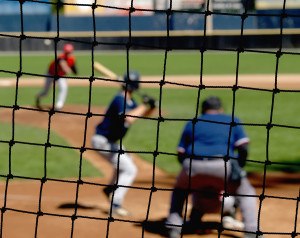A woman died as a result of being struck in the head by a foul ball at Dodger Stadium last August, according to a coroner’s report obtained by ESPN.
Linda Goldbloom was celebrating her 79th birthday and 59th wedding anniversary at a game Aug. 25 when a ball hit by a San Diego Padres player traveled over an area protected by netting and struck Goldbloom in the head. She died four days later at L.A. County-USC Medical Center.
The Los Angeles County coroner’s report said trauma from the batted ball was the cause of death.
The Dodgers said in a statement they were “deeply saddened” by Goldbloom’s death and the “matter has been resolved between the Dodgers and the Goldbloom family.”
For the first time last season, all 30 major league ballparks had expanded protective netting that reached to at least the far ends of each dugout. The push for expansion increased in 2017 after a series of spectator injuries.
Up until last fall, there were no studies that documented spectator injuries.
Study results conducted by University of Alabama at Birmingham research team, Momaya and Brent Ponce, M.D., Will Brabston, M.D., Heath Hale, M.D., Kennieth McCollough, M.D., and Reed Estes, M.D., reviewed two scholarly databases, PubMed and Embase, for studies on spectator injuries. They used a popular internet search engine to find incidents of injury. They found that spectator injuries are not common, but when they do occur they can be life-threatening and life-changing.
Looking back to 2000, the team tracked 181 spectator injuries, with the vast majority – 123 – coming from automobile or motorcycle racing. Cycling experienced 25 injuries, cricket 12, baseball 10 and hockey eight. The team documented 62 fatal injuries; 38 from vehicle racing, 17 from cycling, four from hockey, two from baseball and a single fatal injury from cricket.
“Most of these injuries are ballistic in nature, meaning the spectator was struck by something from the playing area, such as a ball, puck or vehicle,” Momaya said. “There are also instances in sports such as cycling or basketball where a competitor might inadvertently leave the playing area and make contact with spectators.”
Momaya and colleagues are calling for a central database for recording the occurrence of injuries to spectators during sporting events. A database would provide the information needed to gauge whether spectator injuries were increasing or decreasing and could provide insight into whether protective measures instituted by sporting organizations were effective.
 “For example, Major League Baseball recently increased the area covered by netting to reduce the risk of fans being struck by foul balls,” Momaya said. “Without a systematic way to record injuries, there is no way to measure whether that effort is sufficient or if netting should be extended.”
“For example, Major League Baseball recently increased the area covered by netting to reduce the risk of fans being struck by foul balls,” Momaya said. “Without a systematic way to record injuries, there is no way to measure whether that effort is sufficient or if netting should be extended.”
The research team says the findings point to some obvious measures that could be implemented, such as impenetrable barriers at racing events that prevent vehicles or crash debris from entering the spectator area. Increased use of netting at baseball stadiums and higher, transparent barriers in hockey arenas could prevent balls and pucks from striking fans.
“Cricket venues tend to lack protective netting and barriers, which places spectators at increased risk of injury from balls hit into the viewing area,” Momaya said. “Cricket venues should follow the changes implemented by Major League Baseball with extended netting to protect spectators from injuries with high speed balls.”
The Associated Press contributed to this article.
Was this article valuable?
Here are more articles you may enjoy.

 Johnson Controls Unit to Pay $750M to Settle ‘Forever Chemicals’ Lawsuit
Johnson Controls Unit to Pay $750M to Settle ‘Forever Chemicals’ Lawsuit  CoreLogic Report Probes Evolving Severe Convective Storm Risk Landscape
CoreLogic Report Probes Evolving Severe Convective Storm Risk Landscape  National Crime Report Shows Vehicle Thefts Surged to More than 1 Million in 2023
National Crime Report Shows Vehicle Thefts Surged to More than 1 Million in 2023  Dog-Related Injury Claim Payouts Hit $1.12B in 2023, Report Shows
Dog-Related Injury Claim Payouts Hit $1.12B in 2023, Report Shows 